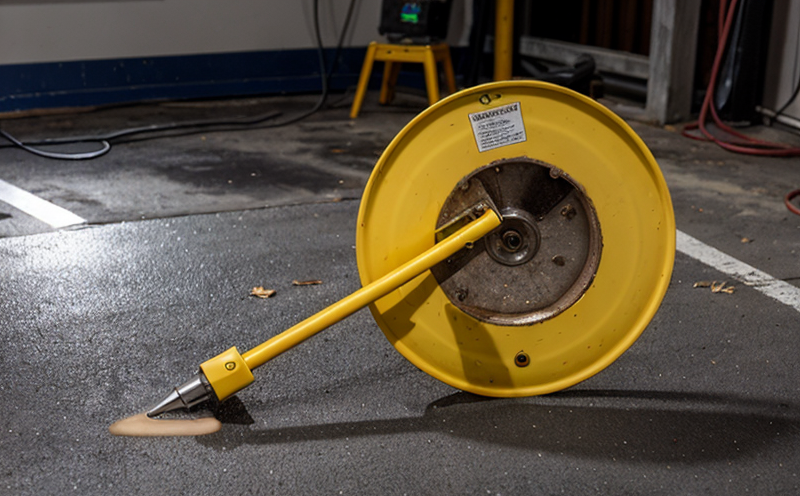ASTM E587 Ultrasonic Thickness Testing of Nonmetallic Materials
The ASTM E587 standard provides a method for determining the thickness of nonmetallic materials using ultrasonic testing. This technique is particularly useful in industries where precision and reliability are paramount, such as aerospace, automotive, and medical device manufacturing. Understanding the thickness of components like composite panels or polymer films ensures that parts meet design specifications and operational requirements.
The ASTM E587 standard specifies the use of ultrasonic waves to measure material thickness non-destructively. This approach is advantageous because it avoids the need for destructive sampling, which can be costly and time-consuming. Ultrasonic testing is ideal for materials that are homogeneous or have a consistent structure, such as those made from composites, polymers, or ceramics.
Before conducting ASTM E587 tests, careful preparation of the specimen is essential. This includes ensuring the surface is clean and free of contaminants to ensure accurate wave propagation. The ultrasonic transducer must be properly calibrated and matched to the material properties. The test setup involves positioning the transducer on one side of the specimen while receiving the echo from the other side.
The ASTM E587 standard outlines specific calibration procedures, including reference block testing with known thicknesses. This ensures that measurements are accurate and reliable. The method also specifies the use of appropriate coupling agents to improve signal transmission between the transducer and the material surface. During the test, the ultrasonic pulse is transmitted through the specimen, and the time it takes for the echo to return is measured.
The thickness measurement is calculated using the formula:
Thickness = (Velocity × Time) / 2
This calculation assumes that the wave travels from one surface of the material to the other. The velocity of sound in the material is a function of its physical properties, such as density and elastic modulus.
The ASTM E587 standard also provides guidelines for interpreting results, including acceptable ranges for thickness measurements. These limits are typically based on the design specifications of the component or part being tested. For example, if a composite panel in an aircraft wing is specified to be 10 mm ± 0.5 mm thick, any measurement outside this range would indicate potential issues that require further investigation.
Ultrasonic thickness testing using ASTM E587 is widely used across various sectors due to its non-destructive nature and high accuracy. It allows for real-time monitoring of material integrity during manufacturing processes, ensuring that components meet stringent quality control standards.
Industry Applications
| Industry Sector | Application |
|---|---|
| Aerospace | Testing composite panels and structural components for thickness uniformity. |
| Mechanical Engineering | Evaluating polymer-based parts used in machinery. |
| Medical Devices | Ensuring the thickness of implantable devices like polymers or composites. |
| Petrochemicals | Checking the integrity of thick-walled pressure vessels and storage tanks. |
| Automotive | Verifying the thickness of composite materials used in vehicle bodies. |
The ASTM E587 standard is particularly valuable in industries where precision and reliability are critical. In aerospace, for instance, ensuring that composite panels meet precise thickness specifications is essential for maintaining structural integrity and operational safety. Similarly, in the automotive sector, accurate thickness measurements of polymer-based parts help prevent failures due to material thinning over time.
The medical device industry benefits from ASTM E587 by ensuring that implantable devices have consistent thicknesses, which can impact their performance and longevity within the human body. Petrochemical companies also use this standard to monitor thick-walled pressure vessels and storage tanks, preventing potential leaks or failures due to material wear.
These applications demonstrate the versatility of ASTM E587 ultrasonic thickness testing in various sectors. By providing accurate and reliable measurements, ASTM E587 helps maintain product quality and safety across different industries.
EuroLab Advantages
- Highly experienced technicians with expertise in ASTM standards.
- Advanced ultrasonic testing equipment for precise measurements.
- Dedicated laboratories equipped to handle various specimen sizes.
- Comprehensive reporting and detailed analysis of test results.
- State-of-the-art calibration facilities ensuring accurate instrument performance.
- ISO/IEC 17025 accreditation, guaranteeing compliance with international standards.
EuroLab’s commitment to quality is reflected in its highly experienced team of technicians who are well-versed in the ASTM E587 standard. Our advanced equipment ensures that thickness measurements are as accurate as possible, while our dedicated laboratories cater to specimens of varying sizes and shapes. Comprehensive reporting not only provides clients with detailed results but also offers insights into potential issues that may arise during testing.
Our state-of-the-art calibration facilities ensure that all instruments perform at their best, contributing to the reliability of test results. EuroLab’s ISO/IEC 17025 accreditation further reinforces our reputation for delivering high-quality services that meet international standards. By partnering with us, clients can trust in accurate and reliable ultrasonic thickness testing conducted according to ASTM E587.
Environmental and Sustainability Contributions
- Promotes the use of non-destructive testing methods reducing waste generation.
- Ensures material integrity leading to longer product lifecycles, thus conserving resources.
- Avoids unnecessary replacement of components, saving raw materials and energy.
- Facilitates recycling programs by identifying damaged or worn-out parts early.
- Promotes the use of sustainable materials through consistent quality assurance.
The ASTM E587 ultrasonic thickness testing method contributes significantly to environmental sustainability. By using non-destructive techniques, this test reduces waste generation associated with destructive sampling methods. Ensuring material integrity helps extend product lifecycles, conserving resources and reducing the need for new raw materials. Avoiding unnecessary replacements of components saves both raw materials and energy.
Early identification of damaged or worn-out parts through ultrasonic testing facilitates more effective recycling programs. This practice not only extends the lifecycle of products but also promotes the use of sustainable materials by ensuring consistent quality assurance. By adhering to ASTM E587, EuroLab plays a crucial role in supporting environmental sustainability and resource conservation.





